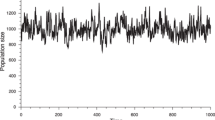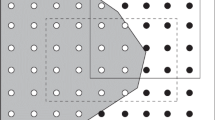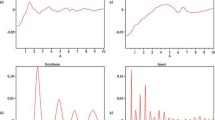Abstract
Information on change in population size over time is among the most basic inputs for population management. Unfortunately, population changes are generally difficult to identify, and once identified difficult to explain. Sources of variation (patterns) in population data include: changes in environment that affect carrying capacity and produce trend, autocorrelative processes, irregular environmentally induced perturbations, and stochasticity arising from population processes. In addition, populations are almost never censused and many surveys (e.g., the North American Breeding Bird Survey) produce multiple, incomplete time series of population indices, providing further sampling complications. We suggest that each source of pattern should be used to address specific hypotheses regarding population change, but that failure to correctly model each source can lead to false conclusions about the dynamics of populations. We consider hypothesis tests based on each source of pattern, and the effects of autocorrelated observations and sampling error. We identify important constraints on analyses of time series that limit their use in identifying underlying relationships.
Access this chapter
Tax calculation will be finalised at checkout
Purchases are for personal use only
Preview
Unable to display preview. Download preview PDF.
Similar content being viewed by others
Literature Cited
Bulmer, M. G. 1975. The statistical analysis of density dependence. Biometrics 31: 901–911.
Cochran, W. G. 1977. Sampling techniques. Wiley and Sons, New York, New York, USA.
Dagum, C. and E. B. Dagum. 1988. Trend. Pages 321–324 in S. Kotz, and N. L. Johnson, editors. Encyclopedia of statistical sciences, Volume 9. John Wiley and Sons, New York, New York, USA.
Dennis, B., P. L. Munholland, and J. M. Scott. 1991. Estimation of growth and extinction parameters for endangered species. Ecological Monographs 61: 115–144.
Draper, N. R., and H. Smith. 1981. Applied regression analysis, second edition. John Wiley and Sons, New York, New York, USA.
Droege, S., and J. R. Sauer. 1990. North American Breeding Bird Survey annual summary, 1989. U. S. Fish and Wildlife Service Biological Report 90(8). Washington, D. C, USA.
Faanes, C. A., and D. Bystrak. 1981. The role of observer bias in the North American Breeding Bird Survey. Pages 353-359 in C. J. Ralph, and J. M. Scott, editors. Estimating the numbers of terrestrial birds. Studies in Avian Biology 6: 353–359.
Fuller, W. A. 1976. Introduction to statistical time series. John Wiley and Sons, New York, New York, USA.
Geissler, P. H., and J. R. Sauer. 1990. Topics in route-regression analysis. Pages 54–57 in J. R. Sauer, and S. Droege, editors. Survey designs and statistical methods for the estimation of avian population trends. U. S. Fish and Wildlife Service, Biological Report 90(1), Washington, D. C, USA.
Gerrodette, T. 1987. A power analysis for detecting trends. Ecology 68: 1364–1372.
Jassby, A. D., and T. M. Powell. 1990. Detecting changes in ecological time series. Ecology 71: 2044–2052.
Keller-McNulty, S., and M. McNulty. 1987. The independent pairs assumption in hypothesis tests based on rank correlation coefficients. The American Statistician 41: 40–41.
Kuno, E. 1971. Sampling error as a misleading artifact in “key factor analysis”. Researches on Population Ecology 13: 28–45.
Lebreton, J-D. 1990. Modelling density-dependence, environmental variability, and demographic stochasticity from population counts: an example using Wytham Wood great tits. Pages 89–102 in J. Blondel, A. Gosier, J-D Lebreton, and R. McCleery, editors. Population biology of passerine birds. Springer-Verlag, Berlin, Germany.
Link, W. A., and J. S. Hatfield. 1990. Power calculations and model selection for trend analysis: a comment. Ecology 71: 1217–1220.
Maelzer, D. A. 1970. The regression of log N n+1 lon log N nas a test of density dependence: an exercise with computer-constructed density-independent populations. Ecology 51: 810–822.
Marchant, J. H., R. Hudson, S. P. Carter, and P. Whittington. 1990. Population trends in British breeding birds. British Trust for Ornithology, Tring, England.
Pollard, E., K. H. Lakhani, and P. Rothery. 1987. The detection of density-dependence from a series of annual censuses. Ecology 68: 2046–2055.
Reynolds, R. E., and J. R. Sauer. 1991. Changes in mallard breeding populations in relation to harvest and productivity rates. Journal of Wildlife Management 55: 483–487.
Robbins, C. S., D. Bystrak, and P. H. Geissler. 1986. The breeding bird survey: its first fifteen years, 1965–1979. U. S. Fish and Wildlife Service, Resource Publication 157. Washington, D. C, USA.
Robbins, C. S., J. R. Sauer, R. S. Greenberg, and S. Droege. 1989. Population declines in North American birds that migrate to the neotropics. Proceedings of the National Academy of Sciences 86: 7658–7662.
Sauer, J. R., R. J. Barker, and P. H. Geissler. 1992. Statistical aspects of modeling population changes from population size data. In W. Kendall, and R. Lacher, editors. The population ecology and wildlife toxicology of agricultural pesticide use: a modelling initiative for avian species.
Sauer, J. R., and S. Droege. 1990. Recent population trends of the eastern bluebird. Wilson Bulletin 102: 239–252.
Sauer, J. R., S. Droege, and D. D. Dolton. In review. A comparison of mourning dove population trend estimates from the call count and North American Breeding Bird Surveys.
Sauer, J. R.,and S. Droege. In press. Geographic patterns of population trends of neotropical migrants in North America. Proceedings of a Conference on the Conservation and Ecology of Neotropical Migrants.
Slade, N. A. 1977. Statistical detection of density dependence from a series of sequential censuses. Ecology 58: 1094–1102.
Solow, A. R. 1990. Testing for density dependence-a cautionary note. Oecologia 83: 47–49.
St. Amant, J. L. S. 1970. The detection of regulation in animal populations. Ecology 51: 823–828.
Sykes, Z. M. 1969. Some stochastic versions of the matrix model for population dynamics. Journal of the American Statistical Association 64: 111–130.
Temple, S. A., and J. A. Weins. 1989. Bird populations and environmental changes: can birds be bio-indicators? American Birds 43: 260–270.
Thompson, K. R., and F. H. Page. 1989. Detecting synchrony of recruitment using short, autocorrelated time series. Canadian Journal of Fisheries and Aquatic Sciences 46: 1831–1838.
Vickery, W. L., and T. D. Nudds. 1984. Detection of density-dependent effects in annual duck censuses. Ecology 65: 96–104.
Walters, C. J. 1985. Bias in the estimation of functional relationships from time series data. Canadian Journal of Fisheries and Aquatic Sciences 41: 147–149.
Yule, G. U. 1926. Why do we sometimes get nonsense-correlations between time-series? — A study in sampling and the nature of time-series. Journal of the Royal Statistical Society 89: 1–69.
Zeger, S. L. 1988. A regression model for time series of counts. Biometrika 75: 621–629.
Author information
Authors and Affiliations
Editor information
Editors and Affiliations
Rights and permissions
Copyright information
© 1992 Elsevier Science Publishers Ltd
About this chapter
Cite this chapter
Barker, R.J., Sauer, J.R. (1992). Modelling Population Change From Time Series Data. In: McCullough, D.R., Barrett, R.H. (eds) Wildlife 2001: Populations. Springer, Dordrecht. https://doi.org/10.1007/978-94-011-2868-1_17
Download citation
DOI: https://doi.org/10.1007/978-94-011-2868-1_17
Publisher Name: Springer, Dordrecht
Print ISBN: 978-1-85166-876-2
Online ISBN: 978-94-011-2868-1
eBook Packages: Springer Book Archive




